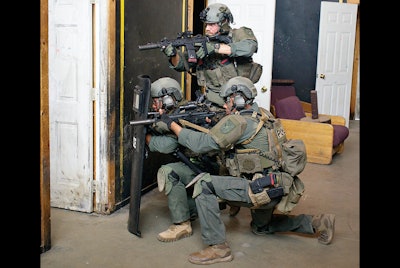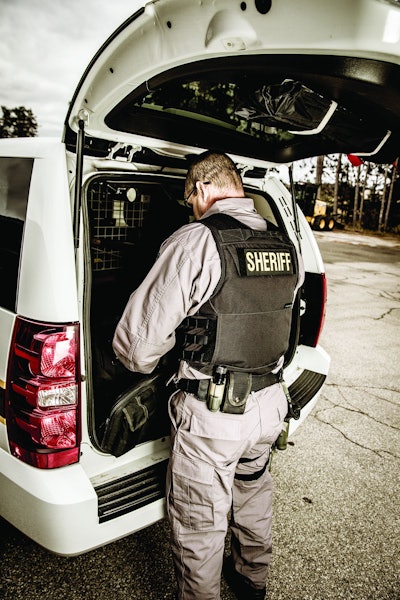 Patrol officers don't have all the equipment and training of tactical units, but they can learn from the tactics, including room clearing from the threshold.Photo: Franklin Rau
Patrol officers don't have all the equipment and training of tactical units, but they can learn from the tactics, including room clearing from the threshold.Photo: Franklin Rau
Starting on the job in a large metropolitan city in the early spring of 1994, I never trained to respond to an active threat the way we do today. Barricaded gunman response, civil disturbance, and setting up a perimetCer to wait for the SWAT team was what I knew.
After the Columbine High School Massacre in 1999, we in law enforcement changed how we respond to active threat calls. The days of waiting outside and containing the incident were long gone and now the attitude was get in there and stop the threat.
Times and tactics have changed since then and we are now in the era of single-officer response, rapid task force response, and advanced trauma care training for patrol. Unfortunately we have seen incidents where officers have either not gone in, or have been ordered to not go in to handle the threat and save lives.
Nearly two decades after Columbine there shouldn't be any question as to what we as law enforcement should do in this situation. We have to respond as safely as possible, grab what we have with us, and stop the killing.
Interior Vs. Exterior
The tactics I recommend for response are the same ones I teach for the National Tactical Officers Association (NTOA) through the Advanced Active Shooter Response Instructor course. We include classroom presentations, MACTAC (Multi-Assault Counter-Terrorism Action Capabilities), exterior response, interior response, and instructor development.
Your active threat program should include response to exterior threats such as what we saw in Boston following the marathon bombing. What if your threat goes mobile, into the residential subdivisions of your jurisdiction? If that happens your interior tactics are out the window and now you need a new plan of action to resolve this issue. Exterior tactics such as bounding, staggered columns, wedges, peels, flanking, and directed fire should all be included in your active threat response program.
Interior tactics have also changed. No longer can you just run into the building and try to process the information your eyes are observing.
You have to decide what mode you're in upon your arrival to the incident. Are you in contact, search, or rescue mode? Is the suspect or threat eliminated? Or is the threat still in the process of committing violence? You must decide what mode you are in and formulate your plan once you make that decision.
Going In
If entry is what you decide to do, there are many ways to complete this task. Some are better than others, and you must seek out those tactics and implement them into your training program.
Your OODA loop and just how fast your brain can process what you are actually seeing has to be factored into the tactics you are employing. The threshold assessment is superior for this very reason and can be implemented by any number of officers that enter the facility.
 A single officer arriving at the scene of an active shooter incident can go in and end the threat. (Photo: Photo: Grand Traverse Co. Sheriff Office/Armor Express)
A single officer arriving at the scene of an active shooter incident can go in and end the threat. (Photo: Photo: Grand Traverse Co. Sheriff Office/Armor Express)
No matter if you're a single officer, or a member of a four-officer element, the threshold assessment will give you the time you need to properly process what is in the room prior to entering it, if needed. If you need to enter the room, it is only to clear potential threats that you cannot clear from the threshold. This allows you and your fellow officers to get through the task of room clearing much more efficiently and effectively.
Hallway movements have gone back and forth as well. If your agency is happy with some sort of center of the hall formation and it works with your room clearing tactics, then continue with it.
I have found that the students I teach prefer a stack type of formation. It allows better cross-angle coverage, easier room clearing and entry, and it keeps the mass of human beings from the middle of the hallway. The formations are up to you, but work through them all to see what works best for the situation and the terrain you deal with.
I have also become a huge fan of the limited penetration style that is taught by the Israelis. I have had the honor of knowing and training with Nir Maman (www.CT707.com) as well as Aaron Cohen (www.cherriescounterterror.com), and I can recommend these gentlemen for your training.
What I like about the limited penetration technique is that all the fighting is done from the threshold and allows you to properly process what's in the room prior to entering it. This is a huge advantage for patrol officers that would not otherwise get the amount of training they need to become proficient in building entry and clearing.
If you and other officers become involved in a use-of-force incident within the room, make sure you finish what you started by handcuffing the suspect, clearing the room, providing medical attention to the wounded, including the suspect, and extracting those that can move to a safer location.
I teach my students to perform chamber checks after they discharge their weapons. It allows them to confirm the weapon is ready to go if needed. Some may disagree with this, but it's something I have picked up from my Israeli trainers and I am wholeheartedly sold on it.
If continued building clearing is needed, make sure someone stays with the suspect. You must also maintain scene integrity and evidence for the investigation and prosecution.
Medical training, including advanced trauma care or tactical emergency casualty care (TECC), must also become a part of your active threat response program. Officers should be carrying tourniquets on their bodies and have fully stocked trauma kits readily available to them in their patrol vehicles. The national Stop the Bleed (https://stopthebleedingcoalition.org) program has some incredible statistics on trauma and how many people actually die from blood loss who could have otherwise been saved if a properly trained person had been at the scene. Officers must have the proper equipment to assist them in responding to these tragic events. Tourniquets are inexpensive and every officer should have one, again on their body, not in their kit in the patrol vehicle.
Simple But Effective
Part of this article has been for patrol officers, part of it for administrators, and part of it for trainers. This part is specifically addressing trainers.
The way I teach officers to respond to active threat is not the only way to respond to active threats, but it is a way. It allows your people to enter and clear the structure more safely and more effectively than other methods. And it offers the benefits of what I call the "4 E's." All of your tactics should be:
- Easy to learn
- Easy to retain
- Easy to recall under stress
- Effective
Some systems for active threat response do not meet all four of these criteria, and this can be a serious problem for many patrol officers who have not had the proper amount of stress-related training when it comes to active threat response.
Keep your tactics simple but effective when it comes to your patrol officers. Make sure they understand the need to stop this incident as soon as possible. The faster they respond, enter, and stop the threat or threats, the more lives they have the potential of saving.
Solid tactics instill confidence in your people. If they don't believe in what you are teaching them, they may not perform them the way you would like them to when you are conducting training or when they have to try to apply them in a real event.
Make sure you seek out the best tactics and training for what your agency requires. The NTOA has been at the forefront from the beginning, and in my opinion the NTOA Advanced Active Shooter Response Instructor course is by far one of the best in the country. The NTOA continues to update and evolve its training based on actual active threat incidents and consults with the nation's experts on these topics. That all culminates into a premier training program that is affordable and obtainable for most, if not all, agencies.
Continually evaluate your active threat response training programs. Tactics evolve and your training programs should be updated when they do. What worked 10 years or 20 years ago may not be the best tactics for your agency today.
Remember that regular training with your officers is the surest way to instill in them the need to handle these incidents in the most efficient and effective manner. They must become proficient and comfortable with the idea of entering a building while possibly only armed with a handgun and confronting an individual armed with a rifle platform. They need to understand they can do this and prevail if they use the right tactics and have the right training.
If your agency doesn't have an active threat response training program for patrol officers, I highly recommend you seek out the training and implement it. Also, reexamine your agency's policy on response to active threat. Has it been updated to incorporate the latest tactics for active threat response or is it something that was written decades ago and hasn't been looked at since?
The front line officer needs to understand how crucially important it is for them to intervene and end the threat. They also need to be trained so that they know how to do this in a smart and safe manner. The training you prepare them with will assist them in prevailing against an active shooter.
Christophor Periatt is a 24-year veteran of law enforcement who teaches for the National Tactical Officers Association and the Macomb Community College Advanced Police Training Center and Police Academy. He is co-owner of Forever Vigilant LLC (www.4evervigilant.com) training company and can be contacted at copsniper69@msn.com.














